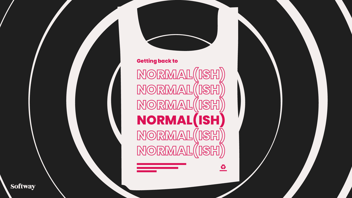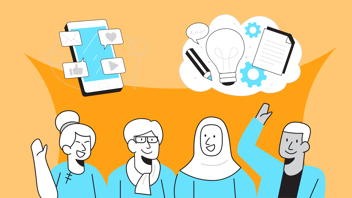

On any given day, a Google search of the phrase ‘return to normal’ returns around 5.8 billion results. It’s been the question hanging in the balance for almost 365 days as every American’s life has been upended by the Coronavirus pandemic. Our daily lives are virtually unrecognizable and many are experiencing unprecedented health challenges, financial obstacles, and social isolation. In the first installment of our Future of Work series, we reflect on the ways in which our work has changed, and how in the face of uncertainty, we can build for a future that better serves organizations and the humans at their core.
Introduction
Our ways of existing in the world have been turned upside down - and there is a deep yearning to rebound back to our normal routines. Our brains have evolved too swiftly navigate the world using schema, a cognitive function that helps quickly interpret and categorize information. Schemas rule all of our processes and accumulate over our lifetimes through new experiences.
The pandemic has upended many of our everyday schema, forcing us to unlearn and relearn many of life's simple tasks like going to the grocery store. But this cognitive dissonance has also forced us to unlearn some of our bigger routines; like how we structure our work and meetings, and how we educate in a classroom. This yearlong process of learning and unlearning has served as a global disorienting dilemma, a catalyst of transformative learning that forced us all to examine our previous assumptions and make new meaning. It has been exhausting to try to reorient ourselves to a new way of being, all while hoping that the current is temporary and we will soon return to our beloved normal.
A normal that never was
The year 2020 has dealt a series of disorienting dilemmas; we not only challenged our assumptions of work and gathering, but many began to critically assess the broader mainstays of society: systemic racism, the effectiveness of government, growing global inequality, and climate change. With our understanding of the world flipped on its head, we were summoned not only to construct new meaning, but also to examine our assumptions around what used to be. Author Sonya Renee Taylor put it aptly:
“We will not go back to normal. Normal never was. Our pre-corona existence was not normal other than we normalized greed, inequity, exhaustion, depletion, extraction, disconnection, confusion, rage, hoarding, hate and lack. We should not long to return my friends. We are being given the opportunity to stitch a new garment.”
What is normal? One could argue that the idea of “normal” is a misnomer. Decades ago, social scientists coined the term VUCA to describe the unexpected turbulence of war. An acronym denoting a volatile, uncertain, complex, and ambiguous environment, the term has evolved in its application to the unstable business landscape as a means of building leadership competencies in agility and resilience. Our world is constantly in tumult; one may argue that normal never was and instead we have clung to long held norms and assumptions as a means of combating the loss of control we feel in a VUCA world. We have collectively accepted assumptions that no longer serve the best interests of many in society.
If we have learned anything from 2020, it's that disruption is the new normal. The disorienting dilemma that the pandemic has presented has shone a light on the collective "truths" of our world that are not truths at all. Assumptions that our best work is completed within the confines of a traditional 40+ hour work week; or that it is sustainable for societies to be driven by economic pursuit without regard for well-being or the climate. What is true is that there is no stasis in our ever evolving world, but we have the opportunity to decide what truths we still hold, and which no longer serve us.
The state of the workplace
The truths we hold about the workplace have been upended as we look at a rapidly evolving business landscape. The traditional structure of the world’s largest corporations, impermeable in their social hierarchies, are being called to confront their own assumptions about what practices are best for business. Traditional organizational structures are expanding into “workforce ecosystems;” according to research from MIT Sloan, it is estimated that over 25% of output is being completed by non-employees as creative and technical expertise is in high demand. Engaging with the vast spectrum of knowledge workers, each with their own motivations and needs, will continue to present organizations with a need to evolve their workforce development strategies.
The demand for employee wellbeing is also rising in importance to employees, a commitment that has not been viewed equally by senior leaders. In a report by Deloitte, individual workers ranked improving worker well-being as one of their top three priorities, while employers ranked well-being as a second to last priority. A focus on well-being will be paramount to employees doing their best work; employers that support the full employee life experience reported a 21% increase in high performers according to Gartner.
The physical infrastructure of the work experience is also transitioning to a more remote centered workplace. Of the changes imposed on the workplace due to COVID-19, an overwhelming 90% of HR leaders reported allowing remote work even after vaccinations are widespread according to a Gartner poll. Major tech companies like Salesforce, Twitter, and Facebook are already permanently institutionalizing hybrid and flexible work schedules with employees merging in office collaboration days with remote work. Yet, organizations are still struggling to cultivate a system of trust as they navigate this remote workforce, with electronic monitoring systems receiving four to five fold increases in use by organizations. Planning for a hybrid workforce in the long term will require organizations to re-imagine talent acquisition and retention processes, accountability, inclusion practices, and employee engagement strategies.
The way forward is through
As organizations face the greatest unknowns, what is guaranteed is the need to invest in strategies that will equip organizations in the face of uncertainty. The pandemic and the simultaneous ongoing crises of systemic racism, widespread global inequality, and a volatile political climate have necessitated that we be intentional about confronting our assumptions. This moment of global disruption and disorientation is ripe for transformation in the workplace - if we can seize the moment. How can organizations lead in a way that confronts assumptions, so that we can rebuild a workplace that may be more fit for humans?
1. Lean into discomfort
When we encounter a disorienting dilemma, we are confronted with two choices: we can assimilate the information, meaning we disregard what doesn’t fit into the confines of our assumptions or we can accommodate it, making room for new schema and ways of thinking. It is our natural reaction to assimilate; to cling tight to what we know to be true, often assumptions we have held our whole lives. Yet simply assimilating this information; looking the other way in hopes that we may return to “normal,” will ensure we never make real lasting change. When confronted with a disorienting dilemma, leaders can guide their employees to lean into the discomfort of change, reframing it as a means for transformation.
2. Build a change readiness practice
In order to lean into disruption as an avenue for impactful change, it’s critical that leaders are intentional about cultivating space that allows employees to increase their change readiness capacity. Resilience is among one of the most powerful tools to employ in the face of change and uncertainty. Managing Director of ChangeFirst, Audra Proctor, writes that resilient people have several key characteristics including optimism, self-assuredness, and an openness to new ideas. How can we cultivate resilient workforces? Organizations should focus on development opportunities where curiosity is encouraged, input is valued, and failure is destigmatized.
3. Cultivate a learning organization
A learning organization is defined as one that “fosters continuous learning and persistently adapts to the transforming environment” (Malik & Garg, 2020). The organizations best positioned to weather a VUCA world are those whose employees feel empowered to ask questions, accommodate new learning, and transfer this knowledge. Dimensions of a learning organization include providing continuous learning opportunities, empowering employees to create a shared vision for the organization, encouraging inquiry and feedback, and establishing systems that allow employees to share and engage in mutual learning (Baiyin Yang, Marsick & Watkins, 2004). As organizations continue to face evolution, incorporating processes that inspire a culture of inquiry and sharing new learning will provide crucial tools necessary to evolve the workplace to a place of true transformation.
Pause and reflect
Taking the time to reflect on both our assumptions, and the possibilities for the future, will guide us as we invite ourselves to chart a new way of work that is better fit for humans. We encourage you to consider your reactions and thoughts to questions such as:
-
If you could stitch a new garment for the future of work, what would it look like?
-
What patterns no longer serve us?
-
What opportunities exist as we stitch this new garment for the future of work?
-
How can work be a haven for humans?
In the next installment of our Future of Work series, we’ll dive deeper into the workplace as we knew it—and why that may no longer serve us.
This series has emerged from a partnership between the Humanizing Initiative and Softway in their joint pursuit of imagining a future way of work that is embedded with humanity at its core.




